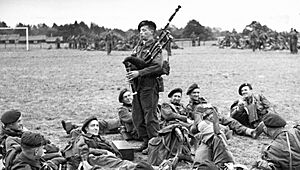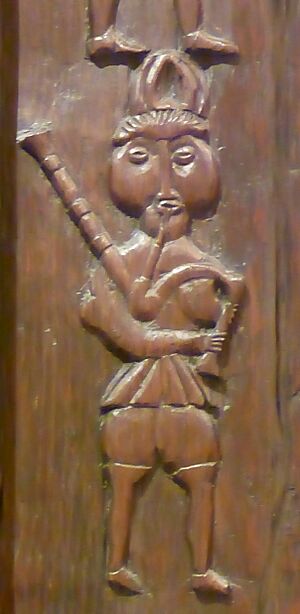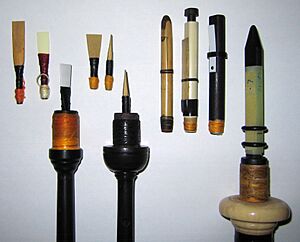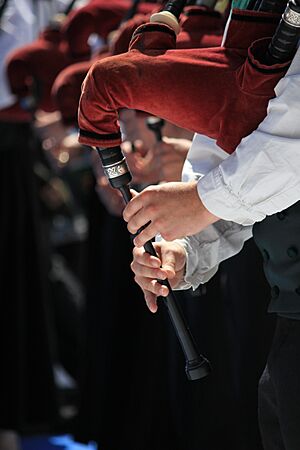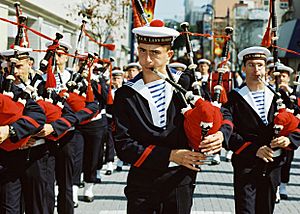Great Highland bagpipe facts for kids

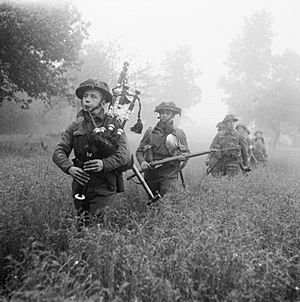
The great Highland bagpipe (called a' phìob mhòr in Scottish Gaelic, meaning 'the great pipe') is a special type of bagpipe from Scotland. It's famous worldwide, especially for its use in the British military and by many pipe bands.
Bagpipes have been in Scotland since about the 1400s. They were first used in battles, which helped the great Highland bagpipe become well-known. While other bagpipe traditions in Europe faded, this one grew stronger.
Besides military and band music, the great Highland bagpipe is also played solo. This special solo style is called pìobaireachd or ceòl mòr. Over centuries, the instrument likely got its modern look and sound around the 1700s.
Contents
The Journey of the Great Highland Bagpipe
We have clear proof of bagpipes in Scotland from about the 1400s. Stories suggest they were played at the Battle of Bannockburn in 1314. Records from 1396 mention "warpipes" used in combat. A poem from 1598 also talks about "Hieland pipes," showing they were special to the Scottish Highlands.
After a major battle in 1746, the king tried to change Scottish culture. While bagpipes were not officially banned, changes in society did affect their popularity.
Highlanders were soon recognized as excellent soldiers. Many Scottish regiments were formed, and they often included pipers. Pipers played their instruments during battles in the 1800s. This continued into World War I, but it became too dangerous for pipers on the front lines.
The tradition of pipers leading soldiers was revived in World War II. In 1943, pipers led attacking companies during the Second Battle of El Alamein. They played special tunes to help units identify each other. Many pipers were lost, so they were not used in combat again during that war.
A famous piper, Bill Millin, played his bagpipes on Sword Beach in Normandy on June 6, 1944. He played under fire during the D-Day landings. The last recorded combat use was in 1967 during the Aden Emergency.
How the Great Highland Bagpipe Works
The great Highland bagpipe is a woodwind instrument, like a clarinet. It uses special parts called "reeds" to make sound. These reeds are hidden inside wooden tubes, unlike most other woodwinds. The bagpipe has four reeds: one for the chanter (which plays the tune) and three for the drones (which play a continuous sound).
A modern set of bagpipes has these main parts:
- A bag to hold air.
- A chanter where you play the melody with your fingers.
- A blowpipe to fill the bag with air.
- Two tenor drones that play a steady, lower note.
- One bass drone that plays an even deeper, steady note.
The chanter plays notes using a special musical scale. This scale gives the bagpipes their unique, bright sound. The drones are tuned to a specific main note, usually called A. Bagpipes generally play at a slightly higher pitch than many other musical instruments.
The chanter reed is usually made from cane (a plant). Synthetic (man-made) chanter reeds exist but are less common. Cane reeds can change their sound as they get wet, which means they might go out of tune. Drone reeds were also traditionally cane, but many pipers now use synthetic drone reeds. Synthetic reeds are more reliable and stay in tune better.
What Materials Make Up Bagpipes?
Long ago, Highland pipes were made from local woods like holly and boxwood. As people traveled and traded more, they started using exotic woods. These included cocuswood, ebony, and African blackwood. These tropical hardwoods became common in the late 1700s and early 1800s.
Today, synthetic materials like Polypenco are also very popular. This is especially true for pipe bands, where it's good for all the chanters to sound the same.
The decorations on bagpipes can be made from many materials. These include ivory, horn, nickel, silver, stainless steel, or imitation ivory. Sometimes other beautiful woods are used for decoration too.
The Unique Music of the Bagpipe
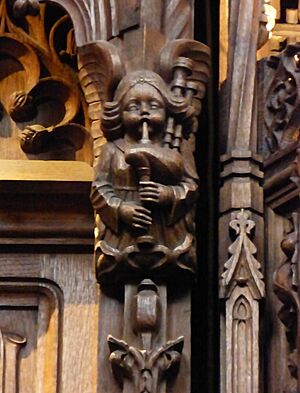
The great Highland bagpipe has a special sound. It can play nine notes, and air flows continuously from the bag. This means you can't easily stop the sound or make notes louder or softer.
To separate notes and add expression, pipers use quick finger movements called "grace notes" or "embellishments." These are tiny, fast notes that make the music lively. Some complex embellishments include doublings, taorluaths, and crunluaths.
All the feeling in bagpipe music comes from these embellishments and how long a piper holds certain notes. Skilled pipers can stretch notes to create beautiful phrasing.
Bagpipe music is divided into two main types: piobaireachd and "light music."
Piobaireachd (pronounced "pee-broch") is the "great music" of the bagpipes. In Scottish Gaelic, it's called ceòl mòr. It starts with a slow main tune. Then, it has a series of increasingly complex variations. It usually ends by returning to the main tune. Famous piping families like the MacCrimmons developed this style.
Light music is also called ceòl beag. This includes many different types of tunes. You'll hear marches, dance tunes (like strathspeys, reels, hornpipes, and jigs), and slow melodies. For competitions, pipers often play a set of a march, strathspey, and reel (MSR).
Bagpipes are rarely played with other instruments because of their unique tuning. They play at a different pitch than most other instruments.
The Bagpipe's Cultural Role
The great Highland bagpipe is important both for solo performances and for groups. In groups, it's usually played as part of a pipe band. A special solo role is the Piper to the Sovereign. This position dates back to the time of Queen Victoria, where a piper plays for the monarch.
Bagpipes in Popular Music
The great Highland bagpipes have also appeared in rock and pop music. Here are some well-known songs that feature bagpipes:
- "Mull of Kintyre" by Wings, with the Campbeltown Pipe Band.
- "Are you ready to rock?" by Wizzard, played by Roy Wood.
- "It's a Long Way to the Top (If You Wanna Rock 'n' Roll)" by AC/DC, played by Bon Scott.
- "Come Talk to Me" by Peter Gabriel, played by Chris Ormston.
- "Shoots and Ladders" by Korn, played by Jonathan Davis.
Bagpipes Around the World
The great Highland bagpipe is played by solo musicians and pipe bands everywhere. It's very popular in places where many Scottish and Irish people have moved, like Canada, the United States, Australia, and New Zealand.
In Former British Empire Countries
Many countries that used to be part of the British Empire also adopted the bagpipe. Examples include India, Pakistan, Malaysia, and Singapore. Bagpipes also spread to parts of Africa and the Middle East, like Jordan, Egypt, and Oman. In Oman, the instrument is called habban.
Bagpipes in Thailand
The great Highland bagpipe also came to Thailand. Around 1921, King Rama VI ordered a set for his royal guard unit. A musician named Khun Saman Siang-prajak learned to play from British soldiers and then taught his unit. This band still practices today.
Bagpipes in Brittany
During World War I, some Breton pipers met Scottish pipers. They brought bagpipes back to Brittany. Polig Monjarret helped introduce the bagpipe to Brittany in the 1920s.
He created the bagad. A bagad is a pipe band with a binioù braz (great bagpipe) section, a bombarde section, and drums. In Brittany, the great Highland bagpipe is called the binioù braz.
Famous Pipe Bands
Some of the most famous pipe bands in the world include:
- The Strathclyde Police Pipe Band
- Shotts and Dykehead Caledonia Pipe Band
- Simon Fraser University Pipe Band
- The Inveraray & District Pipe Band (who are the current world champions)
- The Field Marshal Montgomery Pipe Band
- The St. Laurence O'Toole Pipe Band
- Peoples Ford Boghall and Bathgate Caledonia Pipe Band
All these bands have won the World Pipe Band Championships.
Other Bagpipe Instruments
Here are some other types of bagpipes and related instruments:
- Border pipes: Quieter bagpipes, inflated by bellows.
- Brian Boru bagpipes: Highland bagpipe-based, with extra keys.
- Electronic bagpipes: Digital instruments that mimic Highland bagpipes.
- Great Irish Warpipes: An old Irish instrument, likely similar to the great Highland bagpipe.
- Northumbrian smallpipes: Bellows-blown bagpipes from England.
- Practice chanter: A small, bagless instrument for practicing.
- Practice goose: A small bag with a chanter, used to transition to full bagpipes.
- Reel pipes: Smaller Highland bagpipes for indoor playing.
- Scottish smallpipes: A modern revival of smaller Scottish pipes.
See Also


